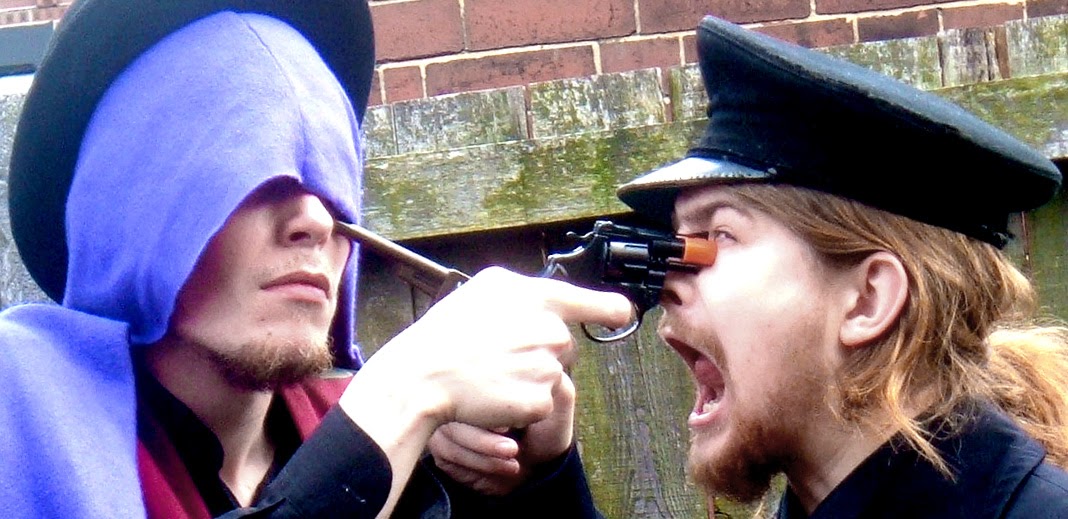Rescued by Rover (1905)
So far as I can tell, this is the first film with a dog in it. Like the more famous Lassie, Rover is a collie dog with a knack for seeking out lost infants, and calling the relevant adults to their aid. It's a strong idea for an early film, as the sight of a dog rushing down lanes and through rivers is something one couldn't represent nearly so well on stage or in print.
The film was made by Cecil Hepworth, a British director who in 1900 made the wonderfully gruesome special effects film 'Explosion of a Motorcar', and in 1903 an excitingly early film of 'Alice in Wonderland'. The man was evidently a smart cookie, realising the potential of the cinema and delivering a blend of narrative and effects (hitherto films had often been one or the other) with a really good framing and timing. Watch it here - it's exactly the sort of melodrama one might expect from the silent age.
Humorous Phases of Funny Faces (1906)
‘Humorous Phases of Funny Faces’ contests with ‘The Merry Frolics of Satan’ to be the most immediately arresting movie title of 1906. It’s a logical progression of the tricks we saw in ‘The Enchanted Drawing’ (1900) - faces are drawn on a blackboard, but come alive and interact with one another. While the earlier film was about the relationship between the artist and the art, this one puts the emphasis on the picture, which suits the camera better. The animated part now fills the whole of the frame, and the artist is a cameo, rather than a star. Quite amusing! Chortle at it here, if you will.If you’re curious, ‘The Merry Frolics of Satan’ is a hand-tinted Méliès film, and has a much less exciting title in its native France It has a great skeletal horse in it, and some fine special effects. Not much Satan, though.
Ben Hur (1907)
Long term readers may know that The 1959 'Ben-Hur' is my favourite film. It’s been shot a few times, and this was the earliest. The film is most notable for having been made without the permission of the rights-holders, meaning the production company were sued for copyright violation.It’s not a very satisfactory adaptation, even by the standards of the age. The film assumes a familiarity with the novel, serving as moving illustrations to aid the imagination, rather than a narrative in pictures. We’re given no reason to think or care about the characters, and when a slate falls from the Hur family’s roof, injuring Valerius Gratus, the camera pays it no heed. If you don’t know the plot, the movie has very little to offer. There are crowds and chariots, but no spectacle, no excitement. Nobody has yet thought of moving the camera to follow the action, and since everything is shown in long shot, there’s no real detail to look at. I suspect most of the cast are in splendid historical costumes of some sort or another, but they’re all just distant blurs. You can watch the film here if you wish.
So, those Bens-Hur, in order of preference:
1. Ben-Hur (1959), a true epic, full of excellent performances and strong dialogue (though some Esther’s more religiose comments in the second half come across rather weakly). This version has the best theology of all, and its chariot race is one of the most exciting sequences in all cinema. Plus, Charlton Heston!
2. Ben-Hur: a Tale of the Christ (1925). Many people favour this silent classic over the 50s talkie. It certainly has style, and some fantastic hats. One of the best American silents, and certainly the most expensive. Its chariot race is pretty thrilling, though technological limitations of the time mean parts of it are too obviously faked in studio. Jesus is manifested as a disembodied arm, which I’m inclined so say lacks his characteristic humanity.
3. Ben Hur (2003). An animated version, which at 80 minutes does most of the things its far-longer predecessor did in 212. It’s for children, so simplifies the story quite a bit, and gives Messala a happy ending.
4. Ben Hur (2010). A TV miniseries. I’m not a fan of this version, with its jerky slo-mo, its disappointing Jesus and its wilfully unmemorable chariots. It tries too hard to avoid copying the 50s film, and so ends up lacking its merits. A good cast, though ill-used.
5. Ben Hur (1907). As above, this is limited by its era, but far more by a lack of imagination. Edwin Porter or Georges Méliès could have made it beautiful.
A new version will be in the cinemas in 2016, so expect me to pop up then to provide heavily biased comparisons with my favourite film.
Japanese Butterflies (1908)
When I resolved to plug some gaps in my chronology, I asked friends if they could name any extremely old films. Two of my lodgers had once seen a movie ‘about butterfly women’ in a museum in Berlin, and a little research revealed it to be ‘Japanese Butterflies’, a Spanish film from 1908.Like a lot of very early films we’ve looked at, it eschews plot for spectacle (though, as mentioned in the film above, sometimes we’re presented with neither), and gives us a number of special effects and striking images. Japan! Some men! Dancing butterflies! A woman! A chrysalis! A giant butterfly! A slightly different giant butterfly! That’s really all there is to it - a of Oriental beauty and mystery, its frames coloured-in by hand. You can watch it right here.
Tune in again for 1909-1912, though since films start expanding from shorts to features (which is to say, films an hour or more in length), these years may be spread across a few posts. Technology is marching on!

























